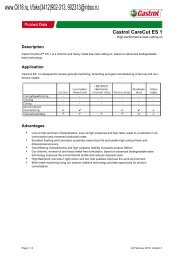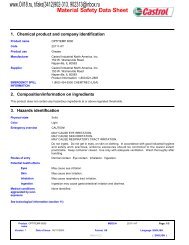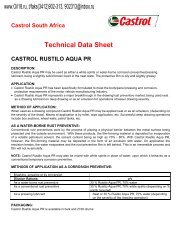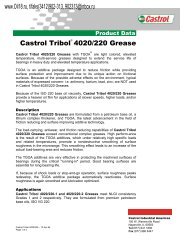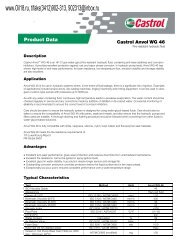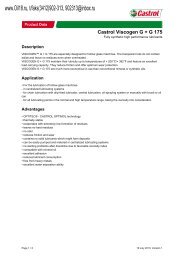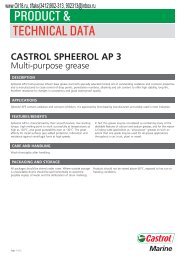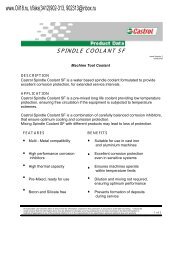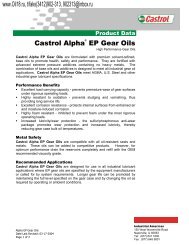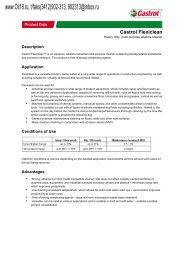PDS: Anvol PE 46 XC
PDS: Anvol PE 46 XC
PDS: Anvol PE 46 XC
Create successful ePaper yourself
Turn your PDF publications into a flip-book with our unique Google optimized e-Paper software.
www.Oil18.ru, t/faks(3412)902-313, 902313@inbox.ru<br />
Product Data<br />
Product Data Sheet<br />
TYPICAL PHYSICAL CHARACTERISTICS<br />
Property <strong>Anvol</strong> <strong>PE</strong> <strong>46</strong> <strong>XC</strong> Test Method<br />
Kinematic Viscosity, cSt @ 100ºC<br />
@ 40ºC<br />
@ 20ºC<br />
@ 0ºC<br />
5<br />
43.4<br />
175<br />
1700<br />
ASTM D445<br />
Specific Gravity @ 20ºC 1.13 IP190<br />
Pour Point, ºC -20 ASTM D97<br />
Neutralisation Nº, mg KOH/g 0.06 ASTM D664<br />
Chlorine Content, ppm 25 Microcoulometric<br />
Water Content, % 0.06 ASTM D1744<br />
Particulate Contamination, (*SAE ARP<br />
749D)<br />
Class 3<br />
Automatic Particle<br />
Counter<br />
Boiling Point@13.3x10-bar(10mm Hg), ºC 262 ASTM D892<br />
Foaming @ 24ºC, ml Tendency<br />
Stability<br />
30<br />
0<br />
-<br />
Air Release @ 50ºC, min 1 IP313<br />
Emulsion Characteristics, min 1 ASTM D1401<br />
Demulsification Nº, sec 165 IP19<br />
NOTE: *SAE ARP 749D is also known as SAE A6D<br />
All reasonable care has been taken to ensure that the information contained in this publication is accurate as at the date of printing. It should be noted<br />
however that the information above may be affected by changes occurring subsequent to the date of printing in the blend formulation or methods of application<br />
of any of the products referred to or in the requirements of any specification approval relating to any such products.<br />
1 of 3
Product Data<br />
Product Data Sheet<br />
FIRE RESISTANT<br />
Property <strong>Anvol</strong> <strong>PE</strong> <strong>46</strong> <strong>XC</strong> Test Method<br />
Flash Point (Open Cup), ºC 2<strong>46</strong> ASTM D92<br />
Fire Point, ºC 368 ASTM D92<br />
Auto-ignition Temperature, ºC 575 ASTM D2155<br />
Wick Ignition, max persistence<br />
of burning, secs<br />
5 NCB 570/1981 (Appendix<br />
B) or Section 3.3.2 **<br />
Spray Ignition,<br />
max persistence of burning<br />
Hot Channel Test<br />
Hot Manifold Ignition, ºC<br />
3<br />
No ignition<br />
No flashing or burning on<br />
tube at 704ºC<br />
Factory Manual Standard<br />
6930<br />
Factory Manual Standard<br />
6930<br />
NOTE: ** 7th Luxembourg Report on specifications and testing conditions relating to<br />
fire resistance fluids used for power transmission in mines, issued by the European<br />
Communities Safety and Health Commission for the Mining and Extractive Industries.<br />
LUBRICATION PRO<strong>PE</strong>RTIES<br />
Property <strong>Anvol</strong> <strong>PE</strong> <strong>46</strong> <strong>XC</strong> Test Method<br />
Vickers Vane Pump Test, hrs<br />
Ring Weight Loss, mg<br />
Vane Weight Loss, mg<br />
Total Weight Loss, mg<br />
250 1000<br />
5.9 7.1<br />
3.3 3.7<br />
9.2 10.8<br />
IP281<br />
4 Ball Wear Test (40kg load for 1hr) 0.6 IP239<br />
Scar Diameter (70kg load for 1hr), mm 2.18 -<br />
FZG Gear Test Failure Load Stage<br />
Specific Weight Loss, mg/kWh<br />
7<br />
0.45<br />
DIN 51354 Part<br />
2 (A/8.3/90)<br />
COMPATIBILITY<br />
<strong>Anvol</strong> <strong>PE</strong> <strong>46</strong> <strong>XC</strong> is compatible with all metals commonly found in electro-hydraulic<br />
control systems. Aluminium should be hard anodised and the use of copper and<br />
copper alloys kept to a minimum. In common with all phosphate ester fluids, special<br />
seals are required and the following materials are suitable: Viton, Butyl Rubber, PTFE<br />
and under certain conditions Ethylene Propylene Rubber. Where painting is necessary,<br />
epoxy resin based paints should be used with <strong>Anvol</strong> <strong>PE</strong> <strong>46</strong> <strong>XC</strong> since other paints may<br />
be softened and lifted.<br />
All reasonable care has been taken to ensure that the information contained in this publication is accurate as at the date of printing. It should be noted<br />
however that the information above may be affected by changes occurring subsequent to the date of printing in the blend formulation or methods of application<br />
of any of the products referred to or in the requirements of any specification approval relating to any such products.<br />
2 of 3
STABILITY<br />
Product Data<br />
Product Data Sheet<br />
Property <strong>Anvol</strong> <strong>PE</strong> <strong>46</strong><br />
<strong>XC</strong><br />
Test Method<br />
Method A W-L-79lb - FTMS<br />
Viscosity Change @ 40ºC, +1.8 5308.6 modified<br />
168hrs @ 150ºC<br />
Acid Value Change (air/hour) mgKOH/g<br />
Metal Weight Changes, mg/cm 2<br />
Magnesium Alloy<br />
Aluminium Alloy<br />
Copper<br />
Cadmium Plated Steel<br />
Mild Steel<br />
+0.09<br />
-0.01<br />
-0.01<br />
0<br />
-0.02<br />
-0.01<br />
5 litres<br />
Method B - DIN 51373<br />
Fluid Neutralisation Nº Increase, mgKOH/g 0.04 -<br />
Absorption Fluid, mgKOH/g Neutralisation Nº<br />
Total Acidity Increase<br />
Metal Weight Changes, mg Copper<br />
Iron<br />
0.01<br />
0.05<br />
+0.3<br />
+0.2<br />
-<br />
-<br />
Hydrolytic Stability ASTM D2619 (modified)<br />
Fluid Layer, mgKOH/g Acid Nº Change<br />
Acidity of Aqueous Layer<br />
Weight Change of Copper<br />
+0.2<br />
0.05<br />
-0.008<br />
-<br />
Health and Safety information sheets are available for all Castrol products from the address below:<br />
Castrol International, Pipers Way, Swindon, Wiltshire SN3 1RE, England., Telephone: Enquiries<br />
+44 (0)1793 512712, Technical Enquiries +44 (0)118 984 3311, Fax +44 (0)1793 453218<br />
All reasonable care has been taken to ensure that the information contained in this publication is accurate as at the date of printing. It should be noted<br />
however that the information above may be affected by changes occurring subsequent to the date of printing in the blend formulation or methods of application<br />
of any of the products referred to or in the requirements of any specification approval relating to any such products.<br />
3 of 3




